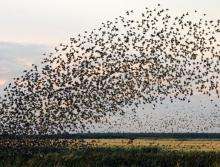August 21, 2013 report
Investigation reveals birds on roads adapt to speed limits

(Phys.org) —Two biologists from Canada working in France have found that birds that land on roads adapt to average highway speeds—the higher the speed limit, the sooner they take flight when a car approaches. In their paper published in the journal Biology Letters, Pierre Legagneux and Simon Ducatez of the University of Quebec and McGill University respectively, describe the field study they conducted timing birds on roads in France.
Most drivers upon encountering birds in the roadway assume that the birds are attempting to gauge their speed and then take flight just before they arrive. This new study by the pair in France suggests that's not how it works at all—instead, birds note how fast cars travel over many days, weeks, months, etc. and build a memory map based on the average speed of such vehicles. When a car approaches, they then pull that data from their brains and use it to decide when to fly away when a car approaches.
The researchers found this out by using a stopwatch to measure how much time birds took to take off from the roadway ahead of them as they drove, which they called the Flight Initiation Distance (FID) and then by stopping to measure the distance traveled. They then set about changing their speed relative to the speed limit, sometimes driving under, over or at the set limit. They also tested birds on different roads with different posted limits, from 20 to 110 kmph. In so doing, they found that the birds studied did not try to guess how fast an individual car was traveling, but instead relied on average speed estimates they'd learned from observing traffic patterns on different roads. They also found that the birds tended to take flight earlier if they were standing in the middle of the road rather than to the side.
In all the team recorded 134 instances of birds taking flight, with over 20 species measured. They noted that larger or heavier birds tended to have longer FIDs then did small agile birds and that FIDs grew longer for all species as the speed limit increased. They suggest most collisions with birds on roadways come about due to drivers exceeding the speed limit, catching the birds by surprise.
More information: European birds adjust their flight initiation distance to road speed limits, Biology Letters, Published 21 August 2013 DOI: 10.1098/rsbl.2013.0417
Abstract
Behavioural responses can help species persist in habitats modified by humans. Roads and traffic greatly affect animals' mortality not only through habitat structure modifications but also through direct mortality owing to collisions. Although species are known to differ in their sensitivity to the risk of collision, whether individuals can change their behaviour in response to this is still unknown. Here, we tested whether common European birds changed their flight initiation distances (FIDs) in response to vehicles according to road speed limit (a known factor affecting killing rates on roads) and vehicle speed. We found that FID increased with speed limit, although vehicle speed had no effect. This suggests that birds adjust their flight distance to speed limit, which may reduce collision risks and decrease mortality maximizing the time allocated to foraging behaviours. Mobility and territory size are likely to affect an individuals' ability to respond adaptively to local speed limits.
Journal information: Biology Letters
© 2013 Phys.org



















